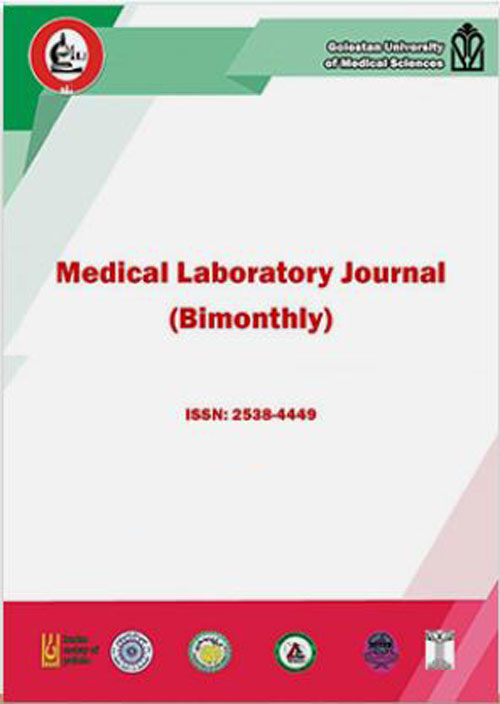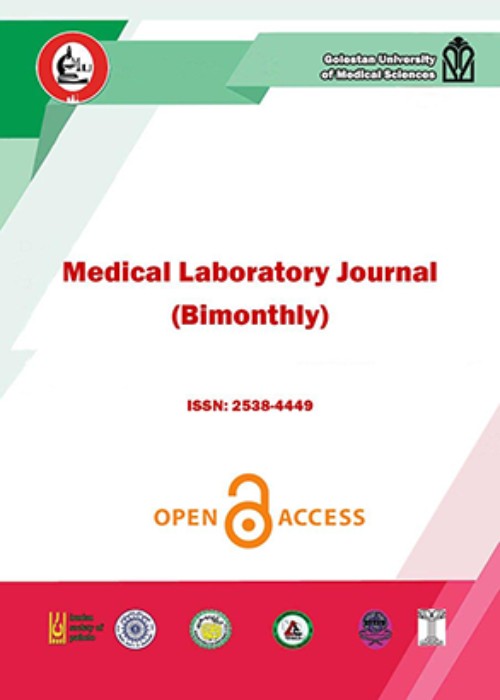فهرست مطالب

Medical Laboratory Journal
Volume:15 Issue: 4, Jul-Aug 2021
- تاریخ انتشار: 1400/04/15
- تعداد عناوین: 8
-
-
Pages 1-5Background and objectives
Tuberculosis (TB) is a serious public health problem and a significant diagnostic and therapeutic challenge worldwide. Molecular diagnostic techniques are crucial parts of the World Health Organization’s new tuberculosis control strategy. This study aims to identify Mycobacterium tuberculosis and rifampin resistance in pulmonary and extra-pulmonary clinical specimens using the Gene Xpert MTB/RIF assay.
MethodsThe study was carried out on 220 specimens from pulmonary and extra-pulmonary TB patients that were sent to the Kavosh Laboratory in Gorgan (Iran) during 2018-20. The Gene Xpert MTB / RIF method was applied to detect M. tuberculosis and rifampin resistance.
ResultsOf 220 specimens, 15 (6.81%) were found to be positive, four (26.6%) of which were related to pulmonary and 11(73.3%) to extra-pulmonary specimens. None of the positive samples was resitant to rifampin according to assay.
ConclusionOur findings demonstrate that the Gene Xpert MTB/RIF is able to accurately detect M. tuberculosis in pulmonary and extra-pulmonary specimens. The accurate and early diagnosis of TB infection allows timely therapeutic intervention, which is beneficial not only for the patient but also for possible contacts.
Keywords: Mycobacterium tuberculosis, Tuberculosis Multidrug-Resistant, Rifampin -
Pages 6-8Background
Klinefelter syndrome (KS) also known as 47, XXY is one of the most prevalent chromosomal abnormalities among men. Infertility is one of the most primary features of this condition. However, there are some other associated features such as thin and tall appearance, absent, delayed or incomplete puberty, small and firm testicles, small penis and gynecomastia.
Case descriptionWe herein report a patient with mosaic KS whose karyotype consisted of 47, XXY/46, XY. The case’s wife had two miscarriages, followed by a healthy girl with a normal karyotype who was born taller than the average at the age of two.
ConclusionMosaic KS dramatically increases the chance of having healthy offspring with normal genetic patterns without performing artificial insemination methods compared to those with complete KS.
Keywords: Klinefelter Syndrome, Chromosome Aberrations, Newborn -
Pages 9-14Background and objectives
Acute myeloid leukemia (AML) is a malignancy that involves the bone marrow and peripheral blood. Some chemokines play a role in the progression, migration and tumor initiation and are therefore associated with poor prognosis. CCL2 promotes tumor growth and is associated with poor prognosis in AML patients. We investigated effects of chemotherapy on serum level of CCL2 in AML patients.
MethodsThroughout this case-control study, blood samples were collected from 25 healthy individuals and 25 AML (M4 and M5) patients before and after the first stage of the current chemotherapy regimen (7+3). Serum level of CCL2 was measured using commercial ELISA kits. Data were analyzed in SPSS 22 using the two-sample t-test and paired t-test.
ResultsBefore chemotherapy, serum level of CCL2 was significantly higher in the patients than in the healthy controls. Following chemotherapy, the serum level of CCL2 reduced significantly to a level comparable to that of the healthy controls.
ConclusionThe current chemotherapy (7+3) can effectively inhibit CCL2 in AML patients.
Keywords: Leukemia, Myeloid, Acute, Chemokine CCL2, Chemokines -
Pages 15-20Background and objectives
Breast cancer is the leading cause of death in women. Cytokines regulate the intensity and continuity of immune response by balancing cell-mediated immunity and humoral responses. This study aimed to investigate the relationship between two polymorphisms of the interleukin-16 (IL-16) gene and risk of breast cancer.
MethodsBlood samples were collected from 80 breast cancer patients and 80 healthy individuals. Polymorphisms rs11556218 T/G and rs4072111 C/T were investigated by polymerase chain reaction-restriction fragment length polymorphism (RFLP-PCR). Then, genotype and allele frequency distributions were evaluated in each group using the SPSS software (version 24).
ResultsThe frequency of genotype rs11556218 differed significantly between the patients and controls (P=0.007). The TG genotype (odds ratio [OR]= 2.471, 95% confidence intervals [CI]: 1.229-4.965, P= 0.001) and total TG+GG genotypes (OR= 3.095, 95% CI: 1.624-5.899, P= 0.001) had a significant relationship with increased risk for breast cancer. The allele and genotype frequencies of rs4072111 C/T polymorphism did not differ significantly between the patients and controls.
ConclusionOur findings suggest that the rs11556218 T/G polymorphism of the IL-16 gene may be associated with susceptibility to breast cancer.
Keywords: Breast Neoplasms, Interleukin-16, Single Nucleotide -
Pages 21-27Background and objectives
Physical activity has long been considered as the cornerstone of interventions for reducing the burden of cardiovascular diseases (CVDs). Homocysteine and obesity indices are important indicators of CVD risk. The present research aimed to evaluate homocysteine and obesity variables in female CVD patients and healthy counterparts with different physical activity levels.
MethodsThis study was carried out on 85 CVD patients (40-55 yr, n=41, 60-75 yr, n=44) and 80 healthy women (40-50 yr, n=40, 60-75 yr, n=40). Subjects were divided into three groups based on their physical activity level: sedentary, moderately active and active. Serum homocysteine, body roundness index (BRI), a body shape index (ABSI), body mass index (BMI) and waist circumference (WC) were measured. Data were analyzed using the independent t-test and one-way ANOVA.
ResultsPhysically active middle-aged CVD patients had significantly lower BRI (p=0.022) and homocysteine (p=0.008) levels compared with the sedentary counterparts. In addition, physically-active old CVD patients had significantly lower BRI (p=0.041), ABSI (p=0.011) and homocysteine (p=0.001) compared with the sedentary counterparts. Physically-active healthy middle-aged individuals had significantly lower BRI (p=0.013) and BMI (p=0.008) levels compared with sedentary counterparts. Active elderly subjects also had significantly lower BRI (p=0.001) and WC (p=0.008) compared with the sedentary counterparts.
ConclusionPhysical activity can reduce the risk of CVD and improve health status of women by reducing homocysteine, BRI and ABSI.
Keywords: Exercise, Cardiovascular Diseases, Homocysteine, Obesity -
Pages 28-32Background and objectives
As a chronic inflammatory airway disease, asthma can increase level of markers of inflammation and muscle damage. In this study, we aimed to evaluate the effects of short-term continuous aerobic exercise combined with vitamin D supplementation on high-sensitivity C-reactive protein (hs-CRP), lactate dehydrogenase (LDH) and creatine kinase (CK) levels in asthmatic women.
MethodsIn this study, 30 overweight (body mass index=26.97± 1.24 kg/m2) women with mild to moderate asthma were purposefully selected.. The subjects received a vitamin D tablet with a daily dose of 1000 IU for six weeks. The training protocol consisted of two sessions of Balke treadmill test (one session before and one session after the vitamin D supplementation). Blood samples were taken before and immediately after the exercise and before and after vitamin D supplementation. Repeated measures ANOVA was used to evaluate changes in the levels of hs-CRP, CK and LDH.
ResultsThe variables were not significantly affected by the exercise and vitamin D supplementation (P>0.05).
ConclusionIt seems that a single session of short-term aerobic exercise and six weeks of vitamin D supplementation do not significantly affect hs-CRP, CK and LDH levels in asthmatic women.
Keywords: Exercise, Vitamin D, C-Reactive Protein -
Pages 33-38Background and objectives
Multiple sclerosis (MS) is a demyelinating and neurodegenerative disease of the centralnervous system that can be tracked through biomarkers of disease status. The present study aimed to examine effect of eight weeks of resistance training on serum levels of neurofilament light chain and tau protein in women with multiple sclerosis (MS).
MethodsThe study population consisted of 24 women with MS (aged 25 to 40 years) in Bojnourd (Iran) with expanded disability status scale score of 2-5. Patients were randomly divided into two groups of resistance training (n=12) and control (n=12). The training group performed 45-60 minutes of resistance training, three sessions a week for eight weeks. The control group did not partake in sports activity. Blood samples were taken 24 hours before the first session and 48 hours after the last training session. Analysis of covariance was used to analyze data at a significance level of 0.05.
ResultsThe eight-week resistance training intervention significantly decreased serum level of tau protein but had no significant effect on serum level of neurofilamet light chain.
ConclusionAccording to the research results, eight weeks of resistance training could have favorable effects on serum level of tau protein in MS patients.
Keywords: Resistance training, Tau proteins, Multiple sclerosis -
Pages 39-44Background and objectives
Different environmental factors, such as infection, can cause Alzheimerchr('39')s disease (AD). Herpes simplex virus types 1 (HSV1) and 2 (HSV2) and cytomegalovirus (CMV) are related to AD. This study explores the potential role of HSV1, HSV2 and CMV in AD progression.
MethodsPlasma samples were taken from 100 AD patients (47 women and 53 men). After isolating viral DNA, PCR was performed using specific primers for the detection of the viruses.
ResultsThe prevalence of CMV, HSV1 and HSV2 was 27%, 8% and 4%, respectively. Although CMV was most prevalent in AD patients, HSV1 and HSV2 were found in patients with advanced AD. The prevalence of HSV1 and HSV2 was significantly associated with dysphoria, hallucination, insomnia and depression (P˂0.05), while CMV was significantly associated with hallucination and dysphoria (P=0.001). AD symptoms were higher in patients with HSV1 and HSV2.
ConclusionIt seems that HSV and CMV infections may be related to the severity of AD.
Keywords: Alzheimer's disease, Epidemiology, Cytomegalovirus


